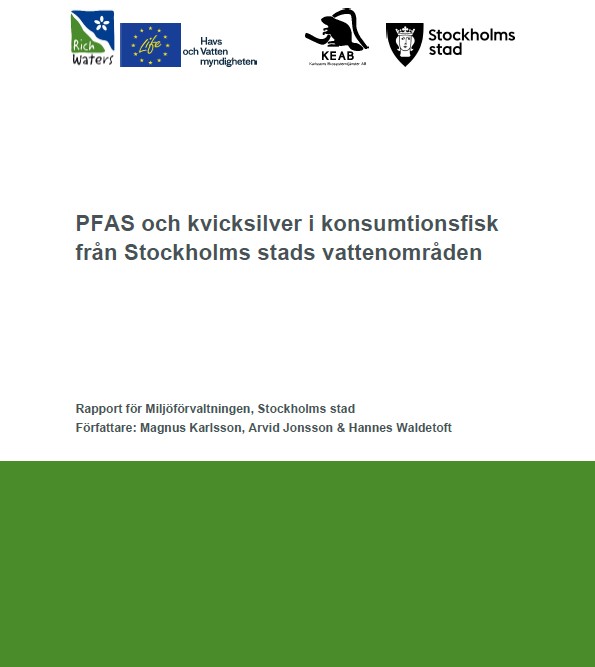The full report is available in Swedish

Summary
Based on collections of fish for consumption between 2021 and 2023 within the City of Stockholm’s environmental monitoring program, the pollution situation regarding PFAS substances and mercury has been evaluated. Average levels in pike, pike-perch, and perch of consumption size have been related to environmental quality standard limits and converted to a theoretical room for consumption based on defined health-related limits for tolerable intake.
The water bodies examined consisted of inner archipelago bays, bays of Lake Mälaren, and smaller lakes.
Levels of ∑PFAS4 varied considerably, with a minimum of 2 ng/g vv in Lake Ältasjön and just under 60 ng/g vv in Lake Magelungen. The occurrence of PFAS substances was entirely dominated by the single compound PFOS. The environmental quality standard limit for PFOS of 9.1 ng/vv was exceeded at 10 of the 19 locations examined. There were also significant variations in mercury levels between the water areas. The highest concentrations were measured in Brunnsviken Bay and Lake Judarn (0.6-0.7 mg/kg vv). The lowest concentration (0.1 mg/kg vv) was measured in Lake Långsjön and Lake Ältasjön. In relation to a typical background value for inland fish of 0.2 mg/kg, the concentrations were elevated in 14 of the water areas.
Intake calculations based on tolerable intakes developed by the European Food Safety Authority (Efsa) indicate that for adults, concerning PFAS, fish consumption can exceed 3 times/per month in Ältasjön. In contrast, the intake from fish in Lake Magelungen and Lake Drevviken may not exceed 1-2 times/year before the tolerable intake is at risk of being exceeded. For mercury, the scope for human consumption is generally larger before the tolerable intake is exceeded, at least 2 times/month.
List of terms
EFSA = European Food Safety Authority
Hg = mercury, a metallic element that occurs naturally in the environment but has increased in the environment due to emissions to air and water from, for example, industry, traffic and combustion. Mercury emissions have generally decreased in recent decades, but elevated levels can still occur in fish – especially freshwater fish.
Me-Hg = methylmercury, an organic bioavailable form of mercury. Virtually all mercury in fish consists of Me-Hg, which is why total mercury (Hg-tot) is usually analyzed.
PFAS = poly- and perfluorinated alkyl substances. A group of industrial chemicals with grease and water-repellent properties that are very persistent in the environment. Some PFAS are banned, such as PFOS, which was banned in the EU in 2008 but is found in the environment due to its persistent properties.
TVI = tolerable weekly intake, the exposure that is considered tolerable to be exposed to through intake via drink and food without risking adverse health effects
ww = indicates in units, e.g., mg/kg ww, that the amount is on a wet weight basis, or fresh weight as it is also called


